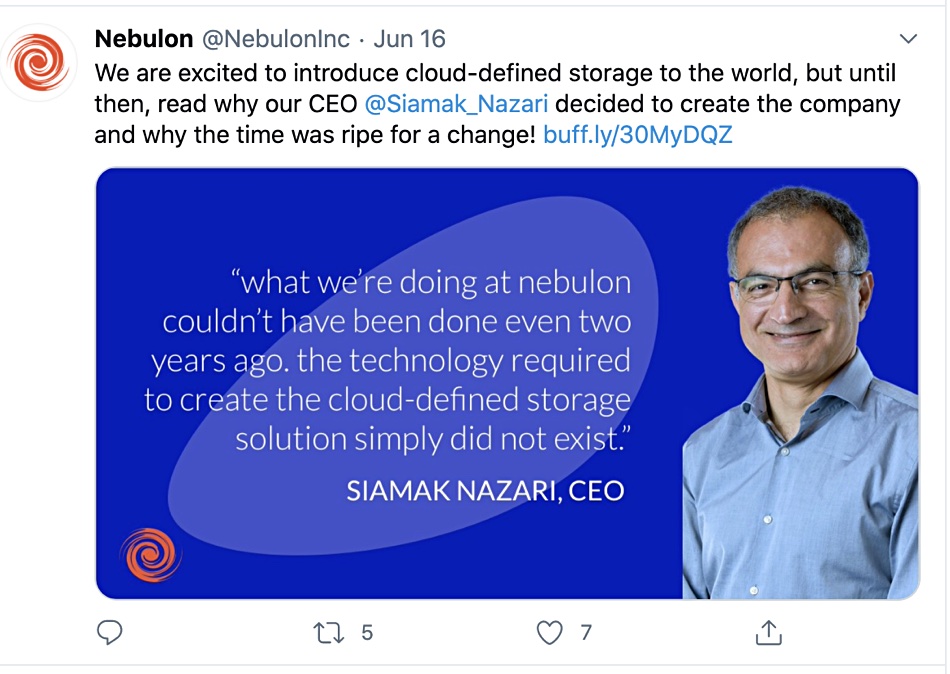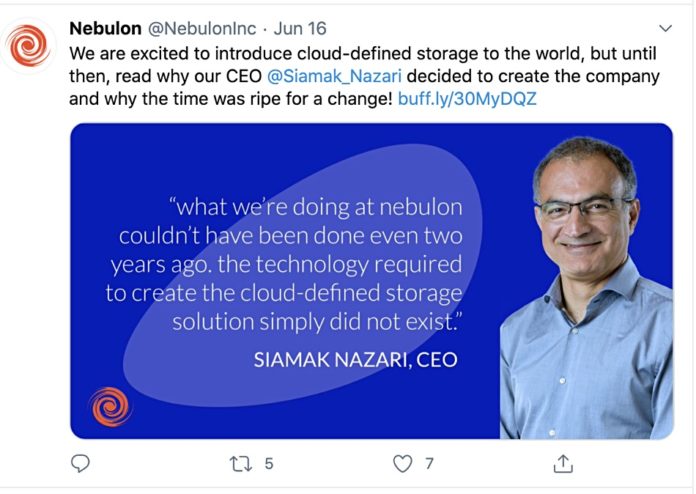Update: No QLC, no GPU. June 24, 2020
Storage startup Nebulon plans to come out of stealth on Wednesday with a hardware-assisted, scale-out, all-flash storage array featuring real-time AI Ops management and a cloud control plane.
Nebulon was started up by 3PAR veterans and first hove into view in November 2018. It revealed initial details about its technology in January this year, via this website.
The company said it plans to launch this week, on June 24, at HPE’s virtual Discover event. Blocks & Files has had a look at some of the material that’s come out from the firm itself as well as the HPE Discover agenda topics to arrive at a view of Nebulon’s tech.
SPU hardware
The hardware is based on on-premises, commodity-based, 2U, 24-slot X86 server boxes that hook up to accessing application servers across Ethernet. This HW forms a scale-out storage resource, to petabyte levels, that uses add-in PCI cards the firm has dubbed Nebulon Storage Processing Units (SPUs).
This is par for the course for some of the 3PAR veterans who work at the startup, who developed an ASIC to handle data reduction operations for the 3PAR array.
Nebulon’s principal product manager, Tobias Flitsch, wrote late last year: “Many modern workloads are built for shared-nothing environments for which these architectures [SAN, SDS, HCI] introduce unnecessary capacity and performance overheads. You know what I’m talking about if you’ve ever tried to run Apache Cassandra, Apache CouchDB, Apache Kafka, etc. on a shared storage array.”
B&F thinks the SPUs will compose Nebulon storage and may sub-divide the storage pool into shared and non-shared storage resources. It could then support both shared storage workloads and shared-nothing workloads such as those Flitsch mentioned.
At HPE Discover the SPUs will be installed into ProLiant DL380 servers. These will be all-flash storage servers, and offer sub-millisecond latency and mission-critical reliability. We estimate this could mean 6 nines or more and NVMe drives.
To have affordable flash capacity at petabyte scale means these storage servers must surely use QLC flash and employ data reduction technology. The SPUs could help with data reduction processing to offload the storage server’s base X86 CPUs.
GPUs?
Siamak Nazari, Nebulon’s CEO, last week tweeted: “What we are doing at Nebulon couldn’t have been done even two years ago, the technology require to create the cloud-defined storage solution simply did not exist.”

Blocks & Files speculates this almost certainly refers to QLC (4bits/cell) flash and, possibly, to GPUs.
There are two sessions at HPE Discover by Nebulon presenters which refer to GPUs: B548 and D566. Both are entitled “Honey, I Shrunk the Enterprise Storage Array to a Cloud-Managed Storage GPU.“ If this is not a tortured metaphor and we take the GPU reference literally, the possibility emerges that the Nebulon storage servers could have GPUs inside them (i.e. fitted to the SPUs).
The Nebulon storage server is managed through a Nebulon ON SaaS management facility or control plane and features AIOps operating in real-time. That could indicate that on-board GPUs run AI machine learning models to control, monitor and optimise the array in real-time, meaning responding to events affecting storage service delivery in seconds or less.
Using GPUs in this way – and again, the inclusion of GPUs is speculation on our part – it could be described as a game-changer. But it is, to say the least, an unusual idea.
The Nebulon storage server will provide storage services for Kubernetes, VMware and Microsoft environments. Nebulon has said nothing about which storage protocols will be supported. Our thinking is that block storage will be supported first, followed by file and maybe object.
Check back with B&F later this week for a deeper look – we’ll soon have a lot more detail.
Update
The Nebulon announcement on June 23 revealed the base details described above were accurate but there is no specific QLC flash support and no use of GPUs in the Nebulon server SAN.








